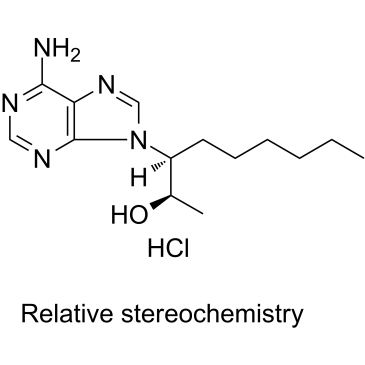EHNA.HCl

EHNA.HCl structure
|
Common Name | EHNA.HCl | ||
|---|---|---|---|---|
| CAS Number | 58337-38-5 | Molecular Weight | 313.826 | |
| Density | 1.27g/cm3 | Boiling Point | 478.2ºC at 760mmHg | |
| Molecular Formula | C14H24ClN5O | Melting Point | N/A | |
| MSDS | USA | Flash Point | 243ºC | |
Use of EHNA.HClEHNA hydrochloride is a specific inhibitor of adenosine deaminase, prevents dAdo degradation and increases mitochondrial dATP levels in fibroblasts[1]. |
| Name | EHNA hydrochloride |
|---|---|
| Synonym | More Synonyms |
| Description | EHNA hydrochloride is a specific inhibitor of adenosine deaminase, prevents dAdo degradation and increases mitochondrial dATP levels in fibroblasts[1]. |
|---|---|
| Related Catalog | |
| References |
| Density | 1.27g/cm3 |
|---|---|
| Boiling Point | 478.2ºC at 760mmHg |
| Molecular Formula | C14H24ClN5O |
| Molecular Weight | 313.826 |
| Flash Point | 243ºC |
| Exact Mass | 313.166931 |
| PSA | 89.85000 |
| LogP | 3.68400 |
| Personal Protective Equipment | Eyeshields;Gloves;type N95 (US);type P1 (EN143) respirator filter |
|---|---|
| Hazard Codes | Xi |
| RIDADR | NONH for all modes of transport |
|
Regulation of autophagic flux by dynein-mediated autophagosomes trafficking in mouse coronary arterial myocytes
Biochim. Biophys. Acta 1833(12) , 3228-36, (2013) Autophagic flux is an important process during autophagy maturation in coronary arterial myocytes (CAMs). Here, we defined the role and molecular mechanism of the motor protein dynein in the regulatio... |
|
|
Adenosine activation of A(2B) receptor(s) is essential for stimulated epithelial ciliary motility and clearance.
Am. J. Physiol. Lung Cell. Mol. Physiol. 301(2) , L171-80, (2011) Mucociliary clearance, vital to lung clearance, is dependent on cilia beat frequency (CBF), coordination of cilia, and the maintenance of periciliary fluid. Adenosine, the metabolic breakdown product ... |
|
|
Adenosine accelerates the healing of diabetic ischemic ulcers by improving autophagy of endothelial progenitor cells grown on a biomaterial.
Sci. Rep. 5 , 11594, (2015) Endothelial progenitor cells (EPCs) seeded on biomaterials can effectively promote diabetic ischemic wound healing. However, the function of transplanted EPCs is negatively affected by a high-glucose ... |
| (2S,3R)-3-(6-Amino-9H-purin-9-yl)-2-nonanol hydrochloride (1:1) |
| 9H-Purine-9-ethanol, 6-amino-β-hexyl-α-methyl-, monohydrochloride |
| 9H-Purine-9-ethanol, 6-amino-.β.-hexyl-.α.-methyl-, monohydrochloride |
| 9H-Purine-9-ethanol, 6-amino-β-hexyl-α-methyl-, (αS,βR)-, hydrochloride (1:1) |
| (2S,3R)-3-(6-Amino-9H-purin-9-yl)nonan-2-ol hydrochloride (1:1) |
| EHNA hydrochloride |
| EHNA.HCl |